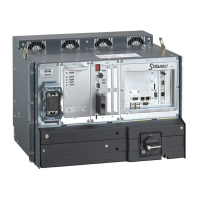© Stäubli 2009 – D28070504A CS8C28 / 248
3.4. SAFETY DIRECTIVES CONCERNING TO PROTECTION OF THE EQUIPMENT
3.4.1. CONNECTIONS
• Before connecting the controller to the power supply, make sure that its nominal voltage does indeed correspond
to the network voltage.
• When connecting the controller, use a cable whose cross-section corresponds to the power rating shown on the
manufacturer's plate.
• Before removing or inserting an electronic component, switch off arm power and then switch off controller power
and comply with the procedure.
• Take care to avoid blocking the air inlets and outlets for the controller airflow path.
• Never use the emergency stop to power down the arm under normal conditions of use.
3.4.2. INFORMATION ON ELECTROSTATIC DISCHARGES
What is an electrostatic discharge?
Everyone has felt the effects of static electricity on their clothes or when they touch a metal object, without being
aware of the damage that can be done to electronic components by static electricity.
Our desire to integrate the notions of quality and reliability in our products makes it necessary to prevent
electrostatic discharges from causing damage to them. This means that all the staff and login users must be
informed.
Storage of a charge
An electric charge is created simply by combining a conductor, a dielectric and the ground (lowest reference
potential, usually the ground in the case of an electrostatic charge).
Example: people, printed circuits, integrated circuits, components, conducting mats when separated from the
ground by a dielectric.
Electrostatic discharges or ESD
Most people have experienced ESD by receiving an electric shock when walking on a carpet and touching a
doorknob or when getting out of a car.
In most case, the following is true:
• To feel an ESD, a charge of at least 3500 V is required.
• To hear one, a charge of at least 5000 V is required.
• To see a spark, a charge of at least 10 000 V is required.
This shows that it is possible to develop charges of over 10 000 V before noticing an electrostatic discharge!
Risks created by an electrostatic discharge
A high ESD voltage (several thousand volts) creates danger for electronic components. A semi-conductor must
be handled carefully to prevent destruction by ESD. It is estimated that ESD destroy only 10% of the components
that they effect. The other 90% of components fall into the "deteriorated" category. A component may be damaged
with simply 25% of the voltage required to destroy it.
These hidden faults can lead to problems that appear several days, weeks or even months after the incident.
Components may also undergo a change in their operating characteristics. Initial tests are successfully passed
but an intermittent error occurs under vibration or temperature constraints. The same components will pass the
"on/off" test successfully, as carried out during repairs, but the problem will reappear again once on site.

